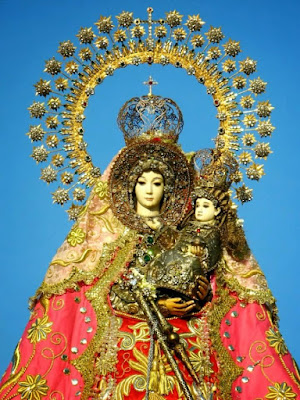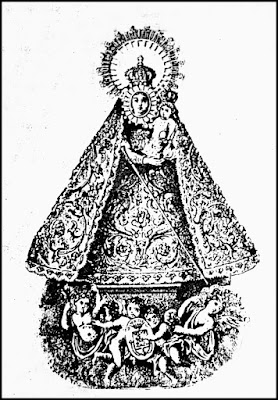Nuestra Señora del Santísimo Rosario de Manaoag - The Lady who Calls
 |
| Nuestra Señora del Santísimo Rosario de Manaoag |
The title's associated image, which dates from the 16th century is enshrined inside the Minor Basilica of Our Lady of the Most Holy Rosary of Manaoag. In Pangasinense, she called as "Apo Baket", a name of reverence as an act of respect to an elder woman. The Manaoag shrine is a major pilgrimage site in the country, and is administered by the Dominican Order within the Archdiocese of Lingayen-Dagupan.
Our Lady of Manaoag, who is invoked as patroness of the sick, the helpless and the needy, is celebrated on two feast days: the third Wednesday after Easter (Patronal Feast), and the first Sunday of October (as Our Lady of the Most Holy Rosary).
 Features of the image
Features of the imageThe statue of Our Lady of Manaoag is a 17th-century ivory image of the Virgin Mary with the Child Jesus enshrined at the high altar of the Basilica. It was brought to the Philippines from Spain via the Manila galleon from Acapulco, Mexico, in the early 17th century by Padre Juan de San Jacinto OP.
The image is a de tallado statue with a huge base so that the image can be vested with fine clothing and this is still being practiced for centuries. One of the most important accessory of the image is the lunette in both the foreheads of the Mother and Child to give its signature look. The image of Our Lady of Manaoag is fully secured within a bulletproof glass enclosure above the new high altar, which has additional wood carvings, an elevated pedestal, and an elaborate altar.
 |
| Apparition of Our Lady of Manaoag |
Documents dating back to 1610 attest that a middle-aged farmer walking home heard a mysterious female voice. He looked around and saw on a cloud-veiled treetop an apparition of the Virgin Mary, holding a rosary in her right hand and the Child Jesus in her left arm, all amidst a heavenly glow. Mary told the farmer where she wanted her church to be built, and a chapel was built on the hilltop site of the apparition, forming the nucleus of the present town. This venerable tradition holds how the town of Manaoag got its name derived from the Pangasinense verb mantaoag, which means "to call" (from the root taoag, "call").
History
The Augustinians built the first Chapel of Santa Monica (the original name of Manaoag) in 1600, at the site of the present graveyard. It was served by the friars from the town of Lingayen, who were succeeded by the Dominicans in 1605 and served from the town of Mangaldan..
 |
| Estampa of Our Lady of Manaoag |
Numerous threats from the Igorot tribes of the surrounding mountains led to the transfer of the entire community to the present site on a hill. The Dominicans started to build a large church on its present site in 1701 under the sponsorship of Gaspar de Gamboa and his wife, Agata Yangta, who were wealthy residents from Manila who moved to Lingayen. Later expansion of the church from 1882 was frustrated by an earthquake in 1892.
During the tumult of the Philippine Revolution for independence from Spain, revolutionaries set fire to church, its treasures, ornaments, and records on 10 May 1898. The image narrowly escaped destruction; it was found abandoned at the back of the church. It was spirited away to Dagupan City, where it was kept from June to October 1898.
 The Dominicans returned in 1901 upon the invitation of Rev. Mariano Pacis, the diocesan priest of Manaoag. Under the aegis of the Dominicans, the church that was started in 1882 was finally completed to a large extent in 1911-12. The central retablo, incorporating Baroque columns from the 18th-century altar, was completed by the famed Tampinco Atelier of Manila. The transepts were completed in 1931-32.
The Dominicans returned in 1901 upon the invitation of Rev. Mariano Pacis, the diocesan priest of Manaoag. Under the aegis of the Dominicans, the church that was started in 1882 was finally completed to a large extent in 1911-12. The central retablo, incorporating Baroque columns from the 18th-century altar, was completed by the famed Tampinco Atelier of Manila. The transepts were completed in 1931-32.The Dominicans ceded all their Pangasinan missions to the diocesan clergy except Manaoag. Spiritual administration of the shrine in perpetuity was granted by the Holy See to the Order of Preachers in 1925.
Miracles
Some of the earliest miracles attributed to Our Lady of Manaoag, including the original apparition, are depicted in the murals in the church.
 In the early days of the Spanish era, animist mountain tribes burnt down newly-Christianised villages. The town of Manaoag was among the settlements that were burnt by the raiders, sending the locals fleeing to the thatch-roofed church. The pillagers's leader climbed over the church compound's crude fence and shot flaming arrows at all parts of the church, but the building miraculously did not catch fire.
In the early days of the Spanish era, animist mountain tribes burnt down newly-Christianised villages. The town of Manaoag was among the settlements that were burnt by the raiders, sending the locals fleeing to the thatch-roofed church. The pillagers's leader climbed over the church compound's crude fence and shot flaming arrows at all parts of the church, but the building miraculously did not catch fire.During the Second World War, enemy Japanese forces dropped several bombs within the church's vicinity. The structure was only moderately damaged. Four bombs were released above the church, with three landing on the plaza and the façade, destroying both. The last bomb fell into the sanctuary, but miraculously did not explode.
A mother went to Our Lady shrine with her dead child and asked the Virgin to bring her child back to life, then all of a sudden, the child came back to life and later serve to the Virgin’s shrine as an act of thanksgiving.
Canonical Coronation
 |
| The Canonical Coronation of Our Lady of Manaoag |
The Minor Basilica of Our Lady of the Most Holy Rosary of Manaoag, located on top of a hill in the town, has been canonically affiliated with the Papal Basilica of Saint Mary Major in Rome since June 2011. The parish encompassing Manaoag and the surrounding towns is administered by the Order of Preachers under the Roman Catholic Archdiocese of Lingayen-Dagupan.
Manaoag Basilica Minore
 |
| The current look of the Minor Basilica of Our Lady of Manaoag |
Some of the miracles attributed to Our Lady of Manaoag are depicted in murals inside the church's transepts and nave. Behind the church are the Parish Office, Museum of Our Lady of The Rosary of Manaoag, Candle Gallery, Pilgrims’ Center and Rosary Garden. There is also an Information Center at the Priory at the left side of the church and souvenir shops at the front office of the church, beside the Veneration Room at the second floor behind the main sanctuary, and at the Candle Gallery in the space behind of the church.
 |
| Official poster for the Proclamation of the Shrine as a Minor Basilica |
On 22 July 2011, the Shrine of Our Lady of The Rosary of Manaoag was elevated to a minor basilica in a ceremony attended by more than 100 archbishops and bishops, leaders of church and state, and numerous devotees. The Shrine was henceforth called the Basilica of Our Lady of The Rosary of Manaoag, headed by a rector appointed by the Archbishop of Lingayen-Dagupan.[5] A special Mass was also held to affirm the "Special Bond of Spiritual Affinity in Perpetuity" between the Manaoag Shrine and the Papal Basilica of Saint Mary Major in Rome.
Canonical affiliation with the Basilica of Sancta Maria Maggiore of Rome
 On 21 June 2011, Cardinal Bernard Francis Law, Archpriest of the Papal Basilica of Saint Mary Major in Rome and Pope Benedict XVI canonically approved the granting of a "Special Bond of Spiritual Affinity in Perpetuity" through which the pilgrims are assured of the same blessings and entitlement to a plenary indulgence equal to that received when visiting a papal basilica in Rome. This was confirmed by the prelate (now Archbishop) of the Lingayen-Dagupan, Socrates B. Villegas, in a circular dated June 13, 2011. The Manaoag Shrine is the first to achieve this status followed by the Shrine of Our Lady of Caysasay in Taal, Batangas, Shrine of Our Lady of the Rosary of Orani in Orani, Bataan and the Diocesan Shrine of Nuestra Senora delos Dolores de Turumba of Pakil, Laguna.
On 21 June 2011, Cardinal Bernard Francis Law, Archpriest of the Papal Basilica of Saint Mary Major in Rome and Pope Benedict XVI canonically approved the granting of a "Special Bond of Spiritual Affinity in Perpetuity" through which the pilgrims are assured of the same blessings and entitlement to a plenary indulgence equal to that received when visiting a papal basilica in Rome. This was confirmed by the prelate (now Archbishop) of the Lingayen-Dagupan, Socrates B. Villegas, in a circular dated June 13, 2011. The Manaoag Shrine is the first to achieve this status followed by the Shrine of Our Lady of Caysasay in Taal, Batangas, Shrine of Our Lady of the Rosary of Orani in Orani, Bataan and the Diocesan Shrine of Nuestra Senora delos Dolores de Turumba of Pakil, Laguna.The official document and a shrine official, who was among the priests who went to Rome, confirmed that the plenary indulgence may be obtained on each visit to the shrine subject to three conditions for each occasion: going to confession immediately before or after the pilgrimage; receiving the Eucharist during the pilgrimage; and praying for the intentions of the Pope; each done in a spirit of detachment from the attraction of sin.
Feasts
 |
| The Original image in procession |
Veneration and Fervent devotion
The archdiocese, in line with the Filipino custom of venerated an image by touching its body or clothing, constructed a staircase that rises to Veneration Room on the second floor behind the apse. The room has pews in front of the alcove behind the image's shrine. Supplicants kneel before the glass small window behind the image's base to pray and touch the hem of the image's mantle, often dropping written prayers into a nearby box.
 |
| Pilgrims lighting candles in a candle station of the Shrine |
The short dawn procession and rosary every first Saturday before the 5 a.m. Mass is well-attended by regular pilgrims mostly from Metro Manila and from Ilocos, Cagayan Valley, Central Luzon. These first Saturday rites are pursuant to the Communion of Reparation on the First Saturdays requested by the Virgin Mary in her third apparition at Fátima on 13 July 1917 for the preservation of world peace. Today thousands continue to flock her shrine to heed her call to her children to give glory to his Son who Redeemed the world.
Through centuries, Apo Baket proven that graces will be bestowed to those who asked for them and heed her call for prayer and penance. The Manaoag Shrine has proven this testament and as long as they are people who heeds her call to live good lives and do whatever His Son tells them to do, she will lavish them graces and protection on their earthly pilgrimage.





Comments
Post a Comment